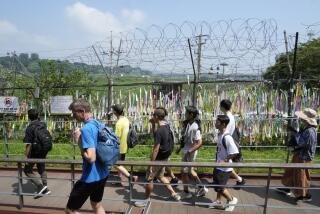Reunited at Last, Video Monitor to Video Monitor
- Share via
SEOUL — There was no hugging, no kissing, no chance to physically release the longings built up after half a century of separation by one of the world’s most impenetrable borders. But for the Koreans who at least had the chance to glimpse one another over large-screen TV monitors, a pilot teleconferencing project that began Monday was the next best thing.
“This in itself is a miracle,” Im Ok Nam, a 58-year-old South Korean, said as she emerged jubilant from a conference room at the Red Cross headquarters in Seoul where she had participated in a teleconference with her 72-year-old brother in Pyongyang, the North’s capital. She had not seen him since the 1950-53 Korean War.
Fiber-optic cables had been laid across the demilitarized zone so the teleconferences could take place in real time. The participants, 226 people representing 40 families, were videotaped in rooms set up in each nation. The North Koreans spoke from a hotel in Pyongyang, while the South Koreans used 11 rooms in Seoul, Pusan, Suwon, Taejon, Inchon, Taegu and Kwangju.
The meetings were broadcast live over South Korean television, which used split screens to show the participants simultaneously. The result was a televised kaleidoscope of emotions almost too powerful to watch.
The North Korean women mostly wore traditional robes known as hanbuk, while many of the men wore their military uniforms, chests adorned with war medals. Many clutched tiny photographs of other family members, which they held up to the cameras.
In one of the most poignant reunions, a wizened 98-year-old South Korean woman in a hospital gown was connected with two daughters in their 70s, whom she hadn’t seen since 1946. Kim Mae Nyo, who relatives said had suffered a stroke, showed no sign of recognizing her children.
“Mom, can you speak? Can you call my name?” one of the daughters cried out in frustration.
Since 2000, 10 face-to-face reunions have been held, allowing a total of 10,000 separated relatives to meet. But the waiting list in South Korea alone numbers 98,000, and thousands of would-be participants die each year.
“Of course, face-to-face reunions are more important. Our idea is not to replace them, but to expand the opportunities for people to participate in reunions,” said Han Wang Sang, head of the South Korean Red Cross, which organized the meetings. “Many people are very old, and this can give them another way to see their families.”
The South Koreans hope the next round of in-person reunions will take place Aug. 26 at the North Korean resort of Mt. Kumgang, after a hiatus of more than a year. The gatherings were stopped by the North Korean regime amid worsening relations with South Korea and rising tensions over the North’s pursuit of nuclear weapons.
North Korean leader Kim Jong Il recently has taken steps to improve ties with the international community, resuming six-nation talks on the nuclear issue and pursuing various economic and tourism ventures with the South. Nearly 200 North Koreans arrived in Seoul on Sunday for joint celebrations commemorating the 60th anniversary of the end of World War II in Asia, which is an important national holiday for both Koreas as it marks the end of Japan’s 35-year occupation of the peninsula.
Despite the well-publicized joint events, the Koreas remain so thoroughly estranged that there is no telephone or postal service between them. The idea of teleconferenced reunions grew out of a landmark 2000 summit in Pyongyang between Kim and then-South Korean President Kim Dae Jung, but its implementation was stalled by tensions between the countries.
“Technically, we could have done this years ago, but there was no political agreement,” said Kim Tae Hun, an official of KT, the South Korean telecommunications firm that installed the cables, video monitors, cameras and microphones for the event.
Some people who participated Monday expressed frustration that they couldn’t hug or kiss their loved ones and that there was no opportunity for private communication.
“I would have liked to ask my brother if he had enough to eat, but I didn’t dare,” said Im, the South Korean woman who teleconferenced with her brother.
But the positives appeared to outweigh the negatives, and one participant said she was relieved to have met her sister over a video monitor rather than in person.
“It would have been too much to bear. I think I would have been so choked up that I couldn’t speak,” said Yi Gyeong Nim, 65. “It was enough to see what she looked like and know that she is alive.”
More to Read
Sign up for Essential California
The most important California stories and recommendations in your inbox every morning.
You may occasionally receive promotional content from the Los Angeles Times.













